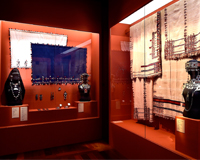Contact Center
.
12 January 2015
“Berber Women of Morocco” Exhibition at Bahrain National Museum


The Berber Women of Morocco Expo will open on Thursday 15th January 2015 at the Bahrain National Museum. The exhibition is being held under the patronage of Her Royal Highness Princess Sabeeka bint Ibrahim Al-Khalifa, Wife of His Majesty the King and President of the Supreme Council for Women (SCW). The Culture directorate is organizing the expo in cooperation with Pierre Berger (Yves Saint Laurent), Jardin Majorelle’s Musée Berbère in Marrakech and Musée du Quai Branly in Paris. The exhibition will run until April 15th 2015.
The exhibition displays the diverse and extraordinary beauty of Berber adornments. Indeed, the Berber (Amazigh) identity developed thousands of years ago on a vast territory that stretches from Morocco’s Atlantic coast to the borders of the eastern Maghreb. Over the millennia it has proven as remarkably resilient to cultural mixing with other Mediterranean civilizations as to various conquests.
Throughout history, women have been the guardians of traditions and language, ensuring the preservation of the tribes’ cultural heritage. Transmission has been guaranteed by many symbols that can be found in weaving (the exclusive province of Berber women), jewelry, wickerwork, pottery, tattoos, and henna body painting. More than 600 intricately detailed decorative objects, including headpieces, jewelry, carpets, textiles, furniture, pottery and one spectacular set of handcarved kohl eyeliner pots, will share space with drawings by the French artist Titouan Lamazou and archival photographs of Berber women sporting the tribe’s traditional dress. Those familiar with YSL’s oeuvre will no doubt spot the influence on the designer’s work.
An invitation to travel into the heart of Morocco and Berber culture, the "Berber Women of Morocco" presents the most beautiful objects carpets, capes, woven belts, necklaces of amber and coral, and silver fibulae. Together with stunning archival photographs, it is a tribute to the women who have never ceased transmitting the Berber culture’s singular identity.







